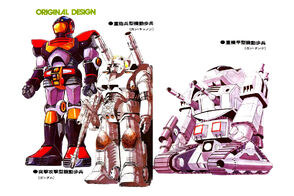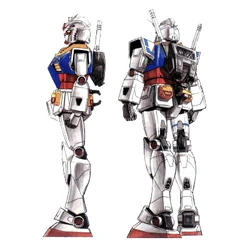No edit summary |
|||
| Line 56: | Line 56: | ||
*[[RX-78AN-01 Gundam AN-01 "Tristan"]] |
*[[RX-78AN-01 Gundam AN-01 "Tristan"]] |
||
**[[RX-78KU-01 Kurwenal]] |
**[[RX-78KU-01 Kurwenal]] |
||
| + | **[[RX-78AN-01FA Gundam Tristan 〈Failnaught〉]] |
||
*[[RX-78E Gundam GT-FOUR]] |
*[[RX-78E Gundam GT-FOUR]] |
||
*[[RX-78EX-PH-1 Zephyr Gundam]] |
*[[RX-78EX-PH-1 Zephyr Gundam]] |
||
Revision as of 06:38, 10 November 2020
The RX-78 Gundam is a series of mobile suits introduced in the Mobile Suit Gundam television series, developed and used by the Earth Federation. The titular mobile suit of the series, RX-78-2 Gundam, is a member of this series and served as the iconic symbol of the many works in the Gundam timelines.
Real life
History

The original design of the three primary mobile suits, "Gundam" (left), "Guncannon" (center) and "Guntank" (right)
The RX-78's initial concept was that of powered armor, the primary design for Yoshiyuki Tomino's proposed series Freedom Fighter Gunboy. The series later changed its name to Mobile Suit Gundam and Kunio Okawara was given Tomino's concept to shape into a finalized design for the anime. Okawara did various designs, including the original design on the right, before settling on the current, more samurai-styled design (see below picture). One of the common questions asked is why did the enemies in the series keep referring to the RX-78-2 as White while it is a mix of blue, red, and white. Tomino's response in the novel version of Gundam is that the original design was to be a grayscale machine, made up of mostly white and light gray coloring. However, Sunrise disapproved of the coloring and insisted the unit be painted in brighter colors to attract attention like other Super Robot anime at that time. As a side note, Hajime Katoki stated in the Gundam Sentinel special edition that, the MSA-0011 S Gundam also went through a similar process but the reason for it is because Bandai authorities thinking the S Gundam did not give a Gundam-ish look until he painted it in the color scheme of RX-78-2.
RX-78-2 later received various variations including a preceding model RX-78-1 and later models RX-78-3~8 by Okawara. Other mechanical designers also add into design units like Yutaka Izubuchi's RX-78-NT-1 from Gundam 0080, and Shoji Kawamori's and Katoki Hajime's Gundam Development Project designs from Gundam 0083. It has also been redesigned for several times by other artists; in particular, the Katoki Hajime version of the Gundam (referred to by Gundam fans and Bandai themselves as Ver. Ka) has become popular enough to be made into both injection plastic model kits sold by Bandai and resin-based garage kits sold by their B-Club subsidiary.
Cultural Influence

Current design of RX-78-2 Gundam
The appearance of the unit is not limited to the Gundam series. RX-78-2 Gundam is one of the basic units that appear in the Super Robot Wars series, ever since the first game for the Game Boy. The RX-78-2 also receives multiple cameo appearances in the anime Sgt. Frog. The current Bandai models' label classification also uses the head of the Gundam as its icon.
Later series keep referencing the nightmare brought along pilots during the One Year War of having a white Mobile Suit appearing in the middle of the battlefield, and anything white is mistaken as a Gundam type Mobile Suit, due to the infamous RX-78-2.
The RX-78 is a pop culture icon in Japan, to the point where Pepsi released several series of Pepsi bottles with special-edition bottle caps featuring miniature statues of various Mobile Suits from the many Gundam anime released over the years. The RX-78 was one of three of these designs (the other two being both the normal Zaku and Char's red Zaku) to get multiple miniatures during the first promotional campaign, including both a full-body sculpture and a sculpture of its bust.
In Fiction
There are two major subsets of mobile suits within this series:
- Those developed under the Project V.
- Those developed under the Gundam Development Project.
History
The deployment of the Principality of Zeon's mobile suits, the MS-05 Zaku I and the MS-06F Zaku II, in the One Year War had given the small nation a major tactical edge over the much larger Earth Federation. Capable of propellant-less maneuvering thanks to their AMBAC systems, and able to be retrofitted to suit a variety of missions and environments, they easily outclassed the Federation's arsenal of fighters and ground vehicles. Realizing that the gap needed to be closed, the Federation instituted Project V (the Vinson Plan in the English translation), a development program that would produce a Federation mobile suit design that would be able to be mass-produced. While the ultimate result of the program was the RGM-79 GM, the engineers in the project tested several design concepts for the mass-production units in the RX-78 series. Some of the developments in the RX-78 models were later incorporated into the GM line, but many were scrapped due to cost and/or complexity.
The official stance is that only 8 RX-78 were produced during the One Year War and this should not be confused with RX-78-[1~8]. The last number is associated with the model number instead of the number of units. There were 8 variations of the RX-78 thus having designations ranging from RX-78-1 to RX-78-8. However, the original 8 units were continuously remodeled and therefore create a misunderstanding that there were a larger number of RX-78 units produced. However, the EFAF (Air Force) created their own RX-78E (GT FOUR/Gundam Transformer/Flight & Operations Unifications Reactors) and is different from the 8 RX-78s produced. Another extra unit is the RX-78XX which uses scrap parts of the RX-78s and are also not considered to be one of the 8 units. After the One Year War, the GP series are numbered after the RX-78 convention but of course are newly produced units.
The RX-78 series introduced Minovsky particles weaponry to mobile suits, developing and deploying the first successful beam rifle and beam saber. These would form the primary component of mobile suit weaponry for at least the next century and a half. The core block system, which allowed the RX-78's pilot to escape the destruction of his mobile suit in a functional aerospace fighter, would be dropped for expense from subsequent units but reused on occasion (most notably in the Anaheim Electronics MSZ-010 Double Zeta Gundam during the First Neo Zeon War) and resurrected by the League Militaire in the UC 0150s on the LM312V04 Victory Gundam. Survivability was also a key issue since the Federation could only make a few Gundam units, both the self-learning computer and mobile suit had to survive. The use of Luna Titanium Alloy for armor solved these problems; 1. It was lightweight. and 2. It was extremely durable. Point blank range shots fired from the Zaku's 120mm machine gun, and 280mm bazooka's had little if no effect on the RX-78-2 Gundam.
After the cessation of the One Year War, the Federation opened up a black-ops mobile suit development program, the Gundam Development Project, in order to develop mobile suits to fill roles that had appeared in the analysis of combat operations from the One Year War. The major reason that the project was designated black-op was because of the RX-78GP02A Gundam "Physalis", which was armed with an atomic bazooka in violation of the Antarctic Treaty. After the events of Gundam 0083, the records of the Gundam Development Project were stricken from the official record. The RX-78 line was finally superseded in UC 0087 by the RX-178 Gundam Mk-II developed by the Titans.
Project V
- RX-78-1 Prototype Gundam
- RX-78-2 Gundam
- RX-78-3 Gundam
- RX-78-4 Gundam Unit 4 "G04"
- RX-78-5 Gundam Unit 5 "G05"
- RX-78-6 Mudrock Gundam
- RX-78-7 7th Gundam
- RX-78-8 8th Gundam
- Only appeared in MSV. The last of the RX-78 project should exist but the only known element is the number. As specified in the MSV, after the production of G-3, there were five more suits numbered number 4 through 8. However, no further information is given in any other places.
Project V in Mobile Suit Gundam: The Origin
A different version of Project V's development line is presented in the alternative continuity of Mobile Suit Gundam: The Origin.
Project G-4 models
- RX-78NT-1 Gundam Alex
- RX-78NT-X Gundam Netix
- RX-78XX Gundam Pixy
Other Models
- RX-78AL Atlas Gundam
- RX-78AN-01 Gundam AN-01 "Tristan"
- RX-78E Gundam GT-FOUR
- RX-78EX-PH-1 Zephyr Gundam
- RX-78SP Gunner Gundam
Combinations
Gundam Development Project models
Please see Gundam Development Project.
Gihren's Greed
Gallery
References
- Gundam Sentinel Special Edition, Model Graphix, ISBN4-499-20530-1

